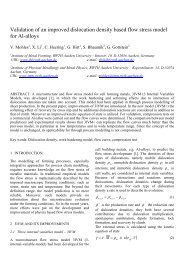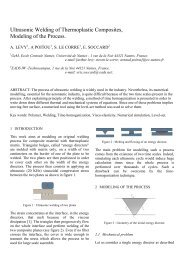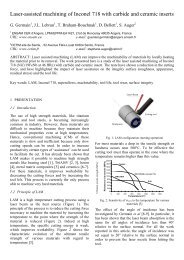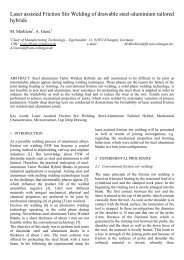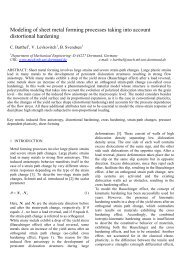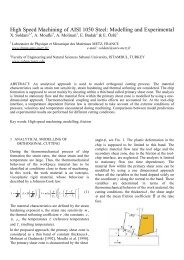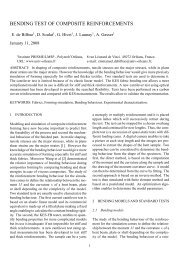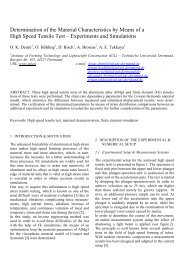Here - the ESAFORM 2008 Conference - INSA de Lyon
Here - the ESAFORM 2008 Conference - INSA de Lyon
Here - the ESAFORM 2008 Conference - INSA de Lyon
You also want an ePaper? Increase the reach of your titles
YUMPU automatically turns print PDFs into web optimized ePapers that Google loves.
case). The same pattern has been found by [9] on hotrolled strips. This proves <strong>the</strong> relevance of thisphenomenon, tentatively attributed to <strong>the</strong> presenceof significant shear stress (die edge / friction) whichinduces <strong>the</strong> rotation of principal axes.zx3.3 Interface3.3.a Delamination / spallingThis is ano<strong>the</strong>r failure mechanism whereby oxi<strong>de</strong>fragments may be spalled off <strong>the</strong> sample surface; inrolling, such fragments may <strong>the</strong>n be embed<strong>de</strong>dinsi<strong>de</strong> <strong>the</strong> strip surface by <strong>the</strong> contact pressure.zyFigure 5: oblique cracks (top) near <strong>the</strong> PSCT die edge,(bottom) on a rolled strip [9].3.2 Roughness transferFigure 6: comparison of <strong>the</strong> oxi<strong>de</strong> surface state after PSCT1with rough / smooth dies. Die width 12 mm. ε = 0. 4 , & ε = 1.s− ,T = 900°C, oxi<strong>de</strong> thickness 50 µm.Figure 8: two examples of <strong>de</strong>lamination. Left: interfacial<strong>de</strong>lamination on <strong>the</strong> flank of a groove. Right: <strong>de</strong>laminationwithin <strong>the</strong> oxi<strong>de</strong> layer.In figure 8 (left), bending of <strong>the</strong> sample in <strong>the</strong> flankof a grooved die (representing <strong>the</strong> “roll banding”<strong>de</strong>fect, i.e. peeling of an orthoradial strip of rolloxi<strong>de</strong>) has resulted in a normal, through-thicknesscrack which has bifurcated along <strong>the</strong> interface; insuch situations, <strong>the</strong> formation and embedding of afragment becomes highly probable. The die grooveis oriented in <strong>the</strong> die width direction, equivalent to<strong>the</strong> rolling direction. Such a crack would thus belongitudinal, contrary to those shown above. Figure8 (right) shows <strong>de</strong>lamination within <strong>the</strong> oxi<strong>de</strong>. Linesof pores have occasionally been found in oxi<strong>de</strong>layers, parallel to <strong>the</strong> interface; <strong>the</strong>y may be <strong>the</strong>origin of such <strong>de</strong>fects. Yet <strong>de</strong>lamination might alsohave taken place at <strong>the</strong> interface, with subsequent reoxidationduring cooling in imperfectly pure N 2 .<strong>Here</strong> again, fragmentation and embedding of <strong>the</strong>spalled layer in <strong>the</strong> next rolling stand is inevitable.Figure 7: cross-section of <strong>the</strong> samples shown in figure 5,showing <strong>the</strong> smooth metal (white) – oxi<strong>de</strong> (grey) interface,whatever <strong>the</strong> die roughness.Ano<strong>the</strong>r possible <strong>de</strong>fect is interface waviness due totool roughness printing, in particular when rolls areseverely worn. Figure 6 shows that <strong>the</strong> oxi<strong>de</strong>surface, to a large extent, takes <strong>the</strong> roll roughness,which suggests a certain <strong>de</strong>gree of plasticity of <strong>the</strong>oxi<strong>de</strong>, but <strong>the</strong> oxi<strong>de</strong> – metal interface remainssmooth (figure 7). This may not be a generalconclusion however, certainly <strong>de</strong>pen<strong>de</strong>nt (i) on <strong>the</strong>ratio of <strong>the</strong> tool roughness to <strong>the</strong> oxi<strong>de</strong> thickness,and (ii) of <strong>the</strong> temperature-<strong>de</strong>pen<strong>de</strong>nt mechanicalproperties of <strong>the</strong> oxi<strong>de</strong> (toughness, oxi<strong>de</strong>-to-metalyield stress ratio). <strong>Here</strong> again, numerical simulationcan contribute in <strong>the</strong> study of <strong>the</strong>se parameters.3.3.b Interface instabilityIn a series of tests <strong>de</strong>voted to varying strain rate, asinusoidal interface waviness has been observed at<strong>the</strong> lowest strain-rate, <strong>de</strong>creasing and disappearingas ε & increases (figure 9).Figure 9: Interface waviness without cracking. Strain rateincreases from top to bottom (0.1, 1 and 10 s -1 ).There is no evi<strong>de</strong>nce of any crack / micro-extrusionphenomenon, hence <strong>the</strong> interpretation by plastic co<strong>de</strong>formationinstability (see [10] e.g.). It is not surethat this can occur in strip rolling, since it has been



